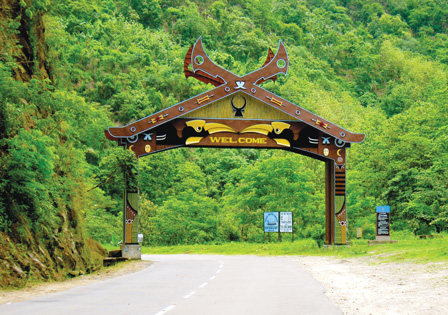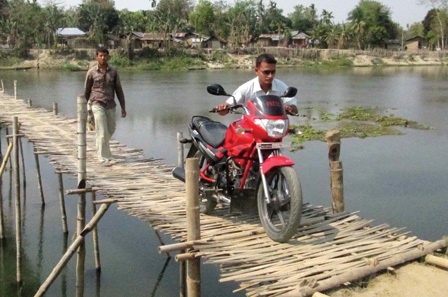ROAD network in NE
Saswati Kaushik
 ‘Country roads, take me home to the place I belong’ – John Denver had famously sung. The roads winding around hills, running straight through the valleys and plains and virtually sailing over water streams – from mighty rivers to brooks, lends an aura of homeliness to the wary travellers to the remotest parts of North East India, while also serving as the lifeline for the inhabitants of this part of the country. The picturesque locations of North East, with its blue hills, green valleys and red rivers, punctuated with the numerous tribes and communities residing in harmonious tandem, are best savoured by a road trip to the region. Roads connect people as much as they connect places and it is more true in a difficult and different terrain such as the North East. From fueling economic growth to accelerating development to bringing people closer, the road network is a vital component in the region’s progress.
‘Country roads, take me home to the place I belong’ – John Denver had famously sung. The roads winding around hills, running straight through the valleys and plains and virtually sailing over water streams – from mighty rivers to brooks, lends an aura of homeliness to the wary travellers to the remotest parts of North East India, while also serving as the lifeline for the inhabitants of this part of the country. The picturesque locations of North East, with its blue hills, green valleys and red rivers, punctuated with the numerous tribes and communities residing in harmonious tandem, are best savoured by a road trip to the region. Roads connect people as much as they connect places and it is more true in a difficult and different terrain such as the North East. From fueling economic growth to accelerating development to bringing people closer, the road network is a vital component in the region’s progress.
The National Highways cover and connect all the eight states of North East, including Sikkim, with the state roadways reaching out to the remote areas of their respective states. The focus on infrastructure development of North East region has made it imperative for growth of the road network, especially with the successive governments in New Delhi viewing the potential of the region to serve as a gateway to the South East Asian countries. Out of the total 82,621 km of National Highway connecting across the nation, 9,613 km run through the North East, accounting for 11.63 per cent. Against the all-India length (km) / 1000 sq km ratio of 25.14, the ratio for North East is 27.99 and for length (km) / lakh population of 6.84 for all-India, it is 8.20 in North East. Among the North Eastern states, Assam has the longest National Highway network of 3068 km, followed by Arunachal Pradesh with 1987 km and Manipur with 1317 km. Meghalaya has a total length of 1171 km of National Highways running through it, while Mizoram has 1027 km within its limits. A total of 494 km of National Highways passes through Nagaland, 400 km through Tripura and 149 km through Sikkim.
The East-West Corridor is being viewed as a major boost to the road network development in North East, once it is completed. The East-West Corridor starts from Assam/West Bengal Border (km 0 of NH-31C) at Srirampur (in Assam) and ends at Silchar, also in Assam, (km 306.25 of NH-54). It passes through Silchar, Maibong, Lumding, Daboka, Nagaon, Sonapur, Guwahati, Nalbari and Bijni, all in Assam, thus making Assam the only state to be directly touched by the East-West Corridor.
The East-West Corridor is being viewed as a major boost to the road network development in North East, once it is completed. The East-West Corridor starts from Assam/West Bengal Border (km 0 of NH-31C) at Srirampur (in Assam) and ends at Silchar, also in Assam, (km 306.25 of NH-54). It passes through Silchar, Maibong, Lumding, Daboka, Nagaon, Sonapur, Guwahati, Nalbari and Bijni, all in Assam, thus making Assam the only state to be directly touched by the East-West Corridor. This East-West Corridor project aims to improve the connectivity of the North Eastern Region with the rest of India through a 670 kms long four-lane divided highway between Srirampur and Silchar. The project is yet to be completed and several revised deadlines, including the latest in December 2014, have been missed. Reasons for delay are many, from problems of land acquisition to acquiring forest clearance to transfer of electric poles, law and order situation in some parts, limited working months due to prolonged monsoons, etc. With Assam being the lone state to be covered by the East-West Corridor at present, there is a popular demand for extension of the Corridor from Silchar to Moreh (in Manipur-Myanmar border) via Jiribam and Imphal; and from Nagaon to Stilwel Road (in Arunachal-China border) via Jorhat, Dibrugarh, Tinsukia and Ledo.
 Road connectivity in North East is being given special thrust with the exclusive Special Accelerated Road Development Programme in North East (SARDP-NE) by the Central government, covering all the eight states in the region. The SARDP-NE aims at upgrading National Highways connecting State Capitals of the region to 2/ 4 lane and to provide connectivity of all 88 District Headquarter towns of North Eastern region by at least 2- lane roads. Improvement of roads of strategic importance in border areas and improving connectivity to neighboring countries are also among the objectives of implementing the SARDP-NE. The SARDP-NE programme has been divided into 3 parts: (i) Phase ‘A’, (ii) Arunachal Pradesh Package of Roads and Highways (Arunachal Package), and (iii) Phase ‘B’.
Road connectivity in North East is being given special thrust with the exclusive Special Accelerated Road Development Programme in North East (SARDP-NE) by the Central government, covering all the eight states in the region. The SARDP-NE aims at upgrading National Highways connecting State Capitals of the region to 2/ 4 lane and to provide connectivity of all 88 District Headquarter towns of North Eastern region by at least 2- lane roads. Improvement of roads of strategic importance in border areas and improving connectivity to neighboring countries are also among the objectives of implementing the SARDP-NE. The SARDP-NE programme has been divided into 3 parts: (i) Phase ‘A’, (ii) Arunachal Pradesh Package of Roads and Highways (Arunachal Package), and (iii) Phase ‘B’.
A total road length of 10,141 km is being targeted to be built across North East under the three parts of the SARDP-NE, at an estimated cost of Rs 33,752 crore (as per original estimates). Out of the total road length, 47 per cent would be national highways (4798 km) and rest 53 per cent would be state roads (5343 km). Under phase ‘A’ of SARDP-NE, total of 4099 km road is targeted to be covered, at a cost of Rs 21,769 crore. The Arunachal Package will cover another 2319 km of road length, costing Rs 11,919 crore while the phase ‘B’ is set to cover 3723 km, at an estimated cost of Rs 64 crore. Arunachal Pradesh will get the longest road coverage benefit under SARDP-NE with 3376 km targeted to be built or improved, followed by 1779 km in Assam, 1222 km in Nagaland, 1147 km in Meghalaya and 1009 km in Mizoram. Sikkim will get road length coverage of 653 km, Tripura 548 km and Manipur 407 km under SARDP-NE. Sanctions have been provided for total road length of 3838.58 km against a cost of Rs 18,715 crore under SARDP-NE till 2013-14. Out of this, a total length of 1152 km has been completed, against allocated fund of Rs 8745 crore.
next
-
Besides the roads within the region, border roads in North East are vital from various aspects, from security to trade. A total length of 2656.11 km of roads have been sanctioned along the India-Bangladesh border in the four North Eastern states of Assam, Meghalaya, Tripura and Mizoram, out of which more than 75 per cent work had been completed nearly two years ago. China is another strategically important neighbour with which North Eastern states of Arunachal Pradesh and Sikkim share its boundaries. As many as 27 roads in the Indo-China border have been sanctioned for Arunachal Pradesh and six roads for Sikkim. The Indo-Tibetan Border Police (ITBP) and Border Road Organisation (BRO) have been entrusted with building these roads in the difficult terrain. In the Indo-Bhutan border in Assam, 16 roads with total length of 313 km have been sanctioned to be built by the state Public Works Department. For Indo-Myanmar border, total length of 4585 km of roads is proposed to be constructed, along with civil aviation facilities.
Enhancing connectivity in North East region holds great significance for promoting greater ties with ASEAN (Association of South East Asian Nations), which in turn will connect India with the wider Asia-Pacific region. Various projects are already underway or in different stages of conceptualization to connect India, via North East region, to its Asian neighbours. A Trilateral Highway project is being implemented which proposes to provide seamless connectivity from Moreh in Manipur to Mae Sot in Thailand via Myanmar. Likewise, work is in progress on the Kaladan Multimodal Transport Project which will provide a road and riverine link between Myanmar and Mizoram as well as connect Indian ports to Sittwe port in Myanmar. There are other connectivity projects such as the Rhi-Tiddim road and Imphal-Mandalay bus service. The Asian Highway 1 travels through North Eastern region of India in its India leg, before entering Bangladesh.The newly-formed National Highway Infrastructure Development Corporation Ltd (NHIDCL) will focus on roads particularly in the North Eastern region and strategic areas of the country. The infrastructure so created would lead to the formation of a more integrated and economically consolidated South and South East Asia. The first tender of the new company pertained to the improvement to 2 lane NH standards of Akajan-Likabali-Bame Road in Arunachal Pradesh with an estimated cost of Rs 272 Crore, thereby underlying the growing focus of the government on North East road connectivity. The Union government had earlier announced a separate corporation, to be headquartered in Guwahati, to build roads in North East.
The slow progress of work of road construction in the North East has been a cause of concern for the Union government. Union Transport Minister Nitin Gadkari had admitted during a recent visit to North East that road projects in the region, especially along the international borders were not progressing on expected lines, and issues pertaining to environment and land acquisition, among others, were delaying the projects. “Projects are pending for two/three years. There have been problems with Border Roads Organization as well. We are trying to sort out the issues and have given priority to those projects,” Mr Gadkari had said. The union minister had specifically mentioned the Northeast sector of the East West Corridor, which is still awaiting completion, and said it would be completed by 2015 even though work is yet to start on a stretch of 31 km of roads between Ballacherra (Cachar) and Harangajau (Dima Hasao) due to environment issues.


